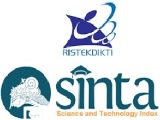MANAJEMEN KONJUNKTIF SUMBER DAYA PERMUKAAN DAN SUMBER DAYA AIR
Abstract
Management of the conjunctive use of surface and groundwater resources is essential, as the combination of these two water resources result in huge advantages for the quality of water, irrigation and economic benefit for the farmers and country. The advantages of proper conjunctive management not only secure the availability of water in the whole year but also can be utilised to provide safer potable water for humans. However, it is not an easy thing to manage both resources since they face several challenges and causes conflict because the nature of surface and groundwater resources is very far different. Furthermore, in order can be used as a safe drinking water then the water resources have to be managed free from contaminants and pollutants. In term of economy, better irrigation system could increase the quality and the quantity of crop’s harvest, make the soil more fertile and productive, and elevate horticulture and viticulture industries. All these things are very essential not only to increase better lives of farmers but also lead to many economic gains to the nation.
Keywords
Full Text:
PDF (Bahasa Indonesia)References
Abu Rumman, M., 2005, “Conjunctive Management of Surface and Groundwater Resources”, SMARTech, p.1. Retrieved 22 October 2008 from http://smartech.gatech.edu/handle/1853/6917?mode=full&submit_simple=Show+full+item+record
Hamlet, 2008, “Archive for the ‘what is water filtration’ category”, Water Filtration, p. 1. Retrieved 23 October 2008 from
http://www.waterfiltrationblog.com/category/what-is-water-filtration/
National Australian Water Commission, 2007, Australian Water Resources 2005, p. 2. Retrieved 27 October 2008 from
http://www.water.gov.au/WaterAvailability/SurfaceWaterAndGroundWaterInteraction/index.aspx?Menu=Level1_3_7
O’Mara G. T. 1988, Efficiency in irrigation”, A World Bank Symposium, p. 17. Retrieved 21 October 2008 fromhttp://www-wds.worldbank.org/external/default/WDSContentServer/WDSP/IB/1999/ 11/04/000178830_98101911135974/Rendered/PDF/multi_page.pdf
Reynolds, M., Jackson, R., 2007, “A case Study Surface Irrigation” Economic benefits of performance Evaluation, p 2. Retrieved 27 October 2008 from
http://www.google.com.au/search?client=firefox-a&rls=org.mozilla%3Aen-US%3Aofficial&channel=s&hl=en&q=irrimate+&meta=&btnG=Google+Search
Tewoh, A., 2008, “What is the difference between surface water and groundwater”, Water Filtration, p.1. Retrieved 22 October 2008 from
http://www.waterfiltrationblog.com/faq/31-what-is-the-difference-between-surface-water-and-ground-water/
White, I., 2007, “Surface water management”, The encyclopedia of earth, p.2. Retrieved 27 October from http://www.eoearth.org/article/Surface_water_management
WHO, 2004, “Water for health”, WHO’s Guidelines for drinking water quality 3rd edition, p. 6. Retrieved 26 October 2008 from
http://www.sahims.net/Search_sahims/Sahims_Doc_2004/documents/Water%20for%20Health%20WHO%20Guidelines%20for%20drinking%20water%20quality.pdf
Wold Bank, 2006, “Conjunctive use of groundwater and surface water”, Agricultural and rural development notes, p. 1. Retrieved 24 October 2008 from http://siteresources.worldbank.org/INTARD/Resources/Notes_Issue6_web.pdf
DOI: http://dx.doi.org/10.30811/portal.v6i1.942
Refbacks
- There are currently no refbacks.
Copyright (c) 2019 ARISMAWAN ARISMAWAN






